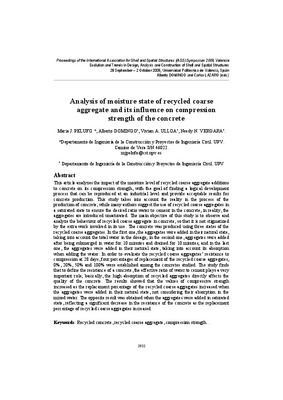JavaScript is disabled for your browser. Some features of this site may not work without it.
Buscar en RiuNet
Listar
Mi cuenta
Estadísticas
Ayuda RiuNet
Admin. UPV
Analysis of moisture state of recycled coarse aggregate and its influence on compression strength of the concrete
Mostrar el registro completo del ítem
Pelufo Carbonell, MJ.; Domingo Cabo, A.; Ulloa Mayorga, VA.; Vergara Acuña, NN. (2009). Analysis of moisture state of recycled coarse aggregate and its influence on compression strength of the concrete. Editorial Universitat Politècnica de València. http://hdl.handle.net/10251/6652
Por favor, use este identificador para citar o enlazar este ítem: http://hdl.handle.net/10251/6652
Ficheros en el ítem
Metadatos del ítem
| Título: | Analysis of moisture state of recycled coarse aggregate and its influence on compression strength of the concrete | |
| Autor: | Pelufo Carbonell, María José Ulloa Mayorga, Vivian Andrea Vergara Acuña, Needy Nayiv | |
| Editor: | ||
| Entidad UPV: |
|
|
| Fecha difusión: |
|
|
| Resumen: |
This article analyzes the impact of the moisture level of recycled coarse aggregate additions to concrete on its compression strength, with the goal of finding a logical development process that can be reproduced at an ...[+]
|
|
| Palabras clave: |
|
|
| Derechos de uso: | Reserva de todos los derechos | |
| ISBN: |
|
|
| Fuente: |
|
|
| Editorial: |
|
|
| Título del congreso: |
|
|
| Lugar del congreso: |
|
|
| Fecha congreso: |
|
|
| Descripción: |
|
|
| Tipo: |
|







